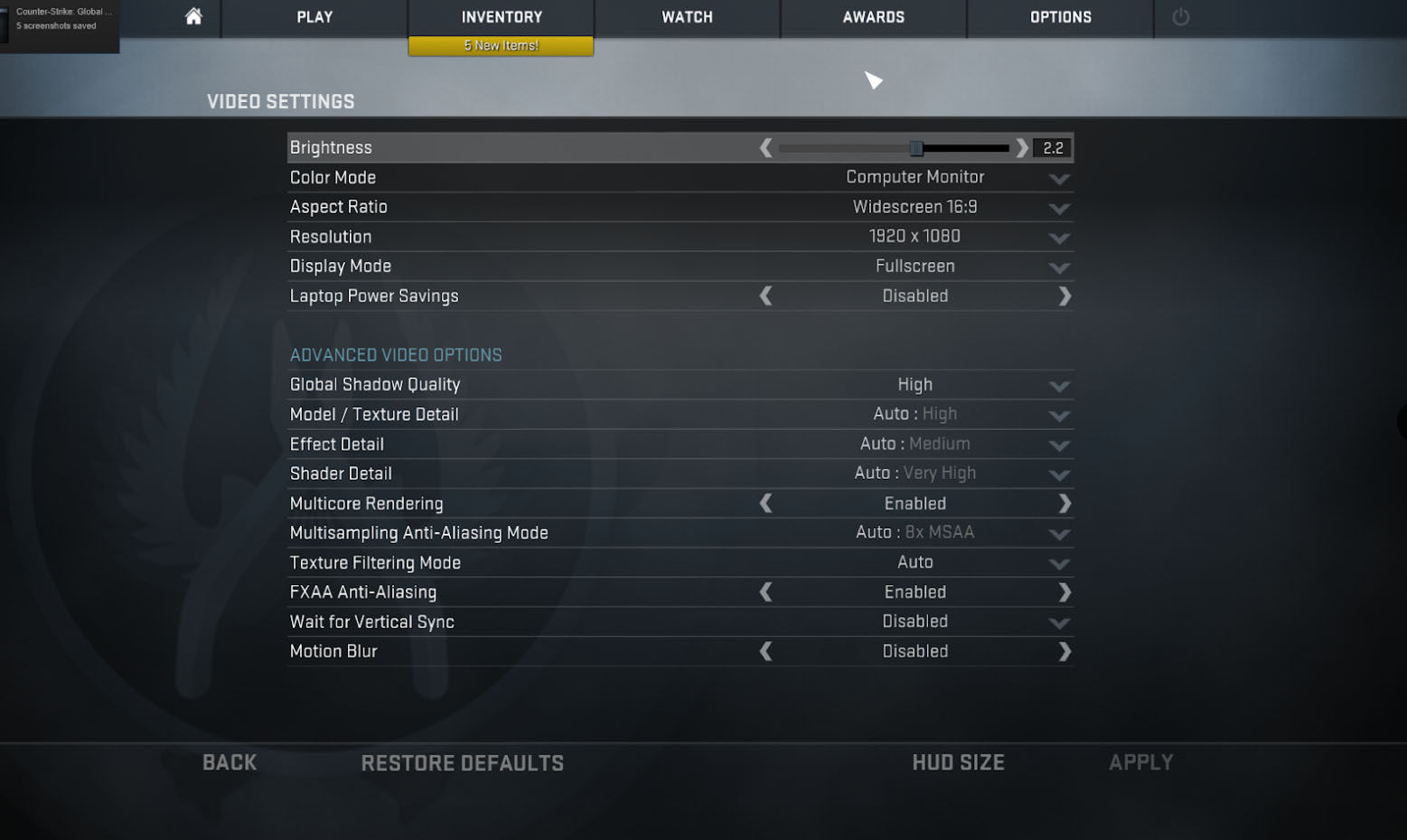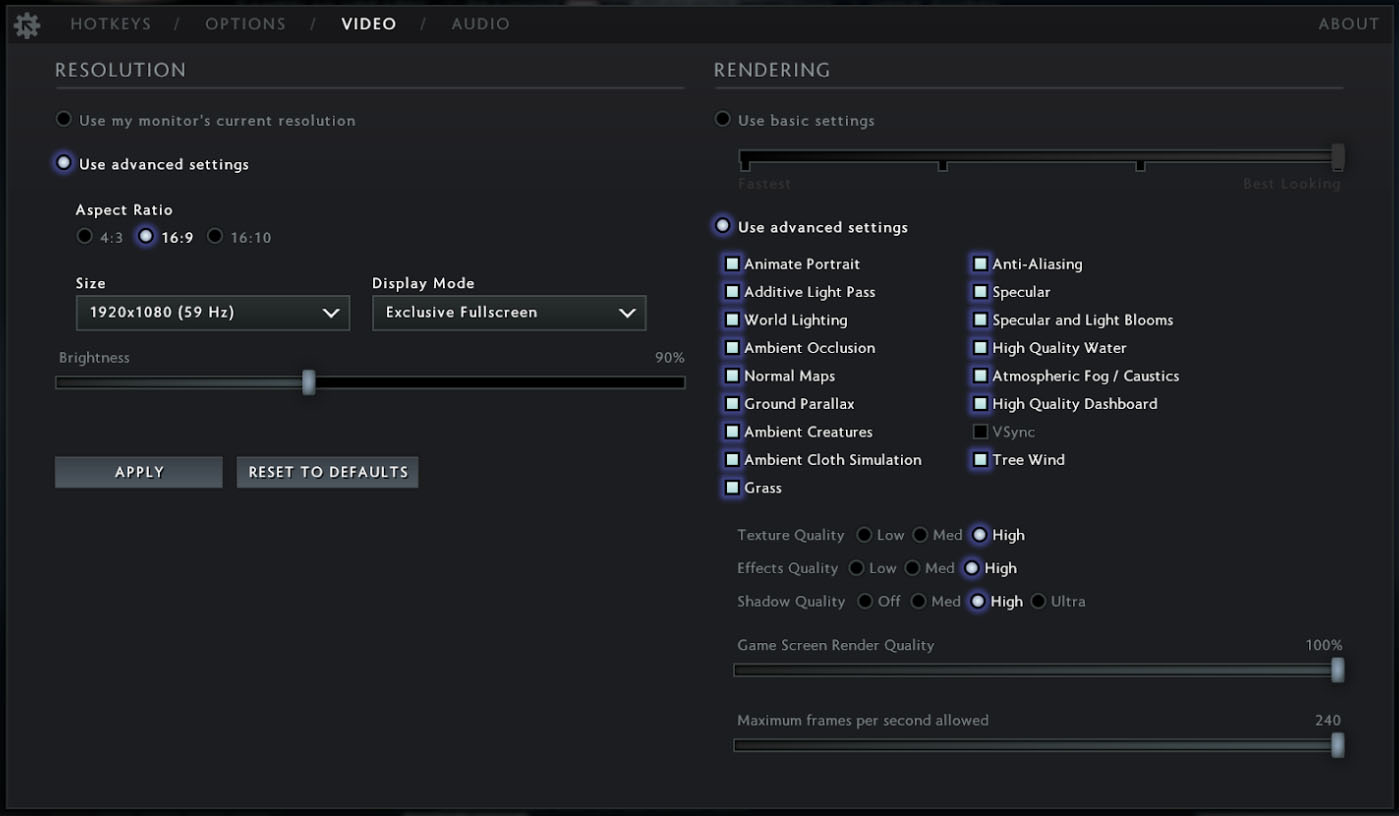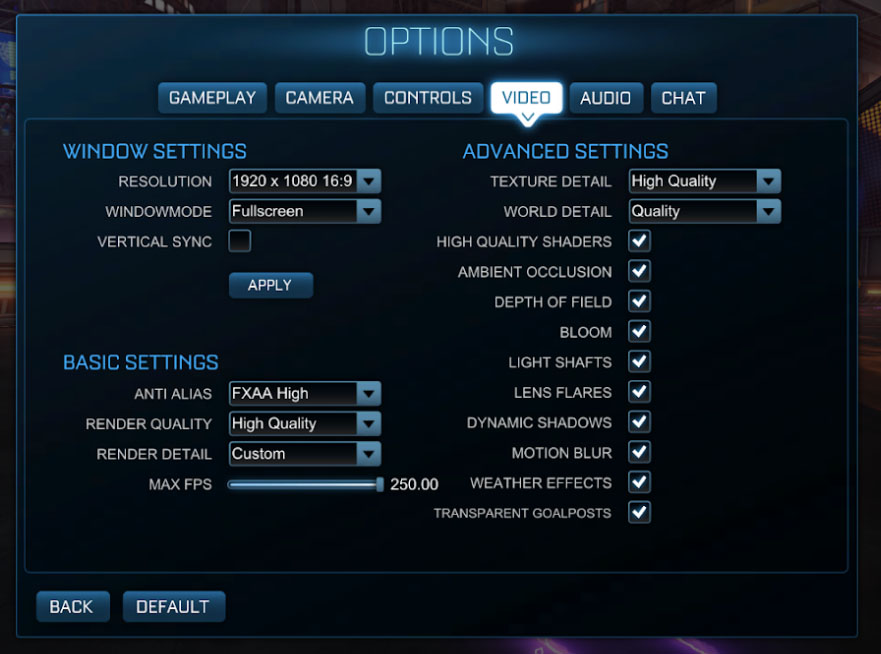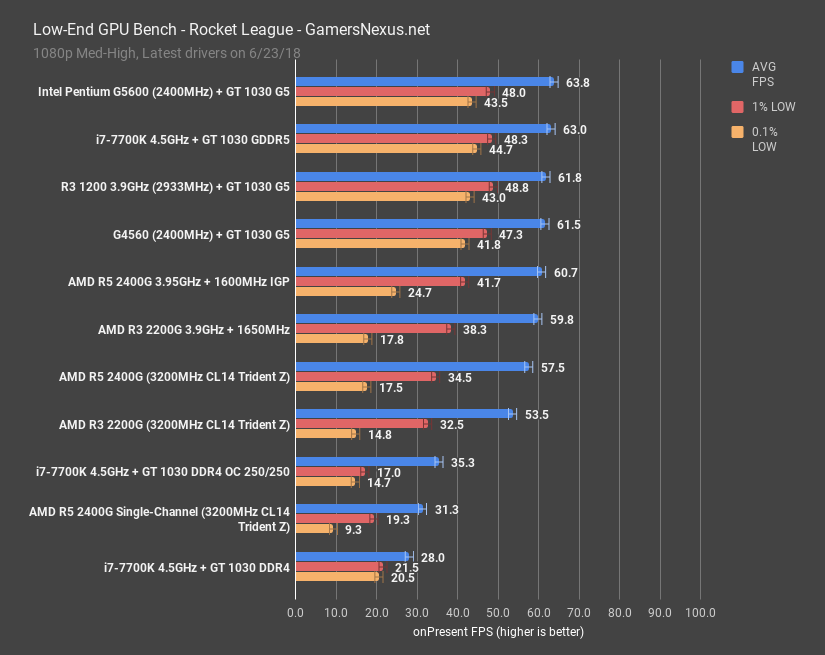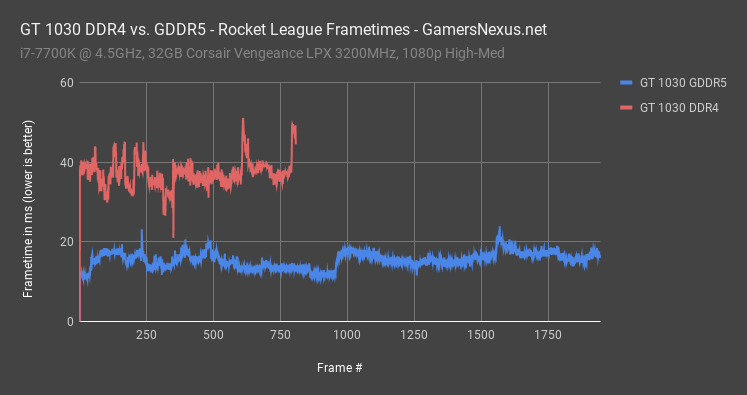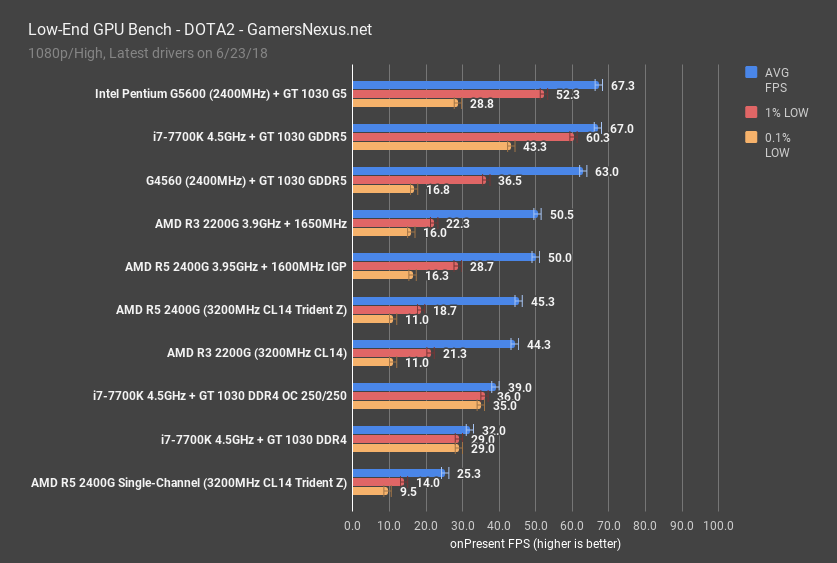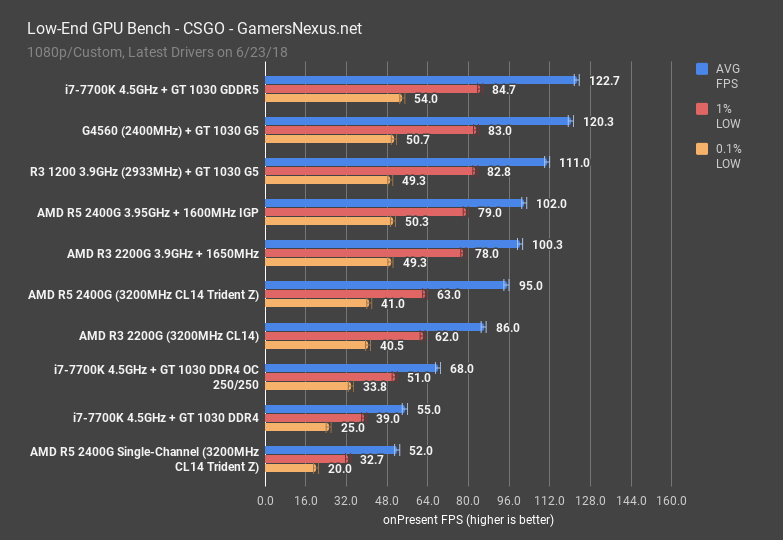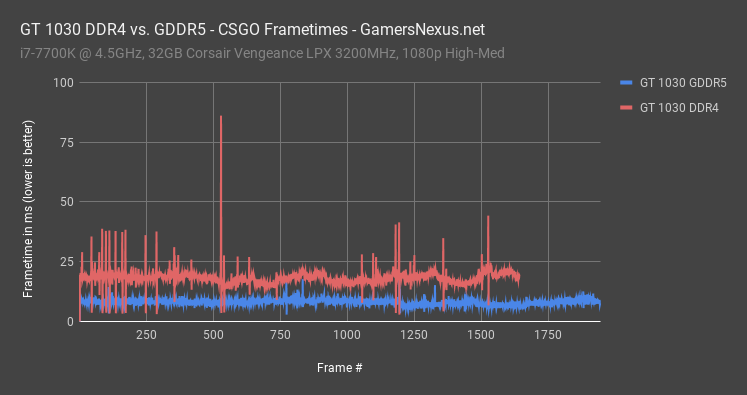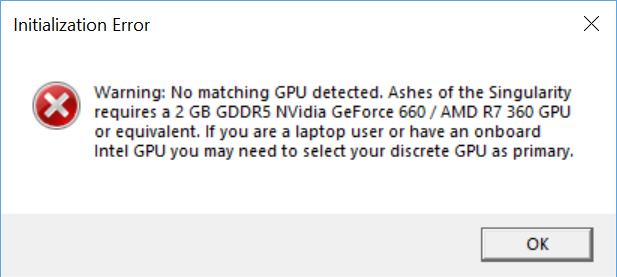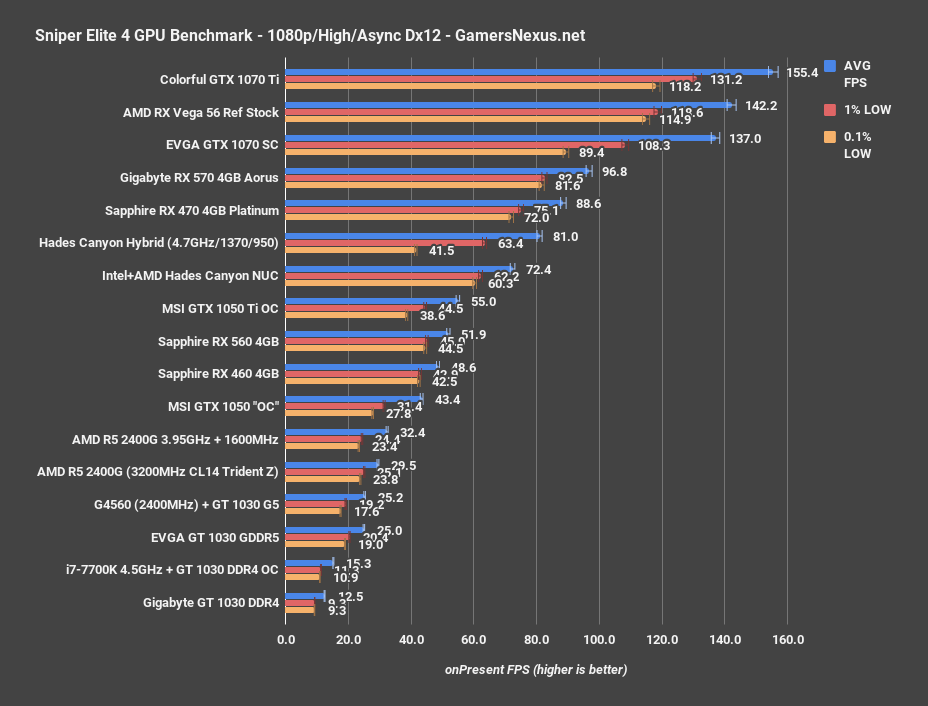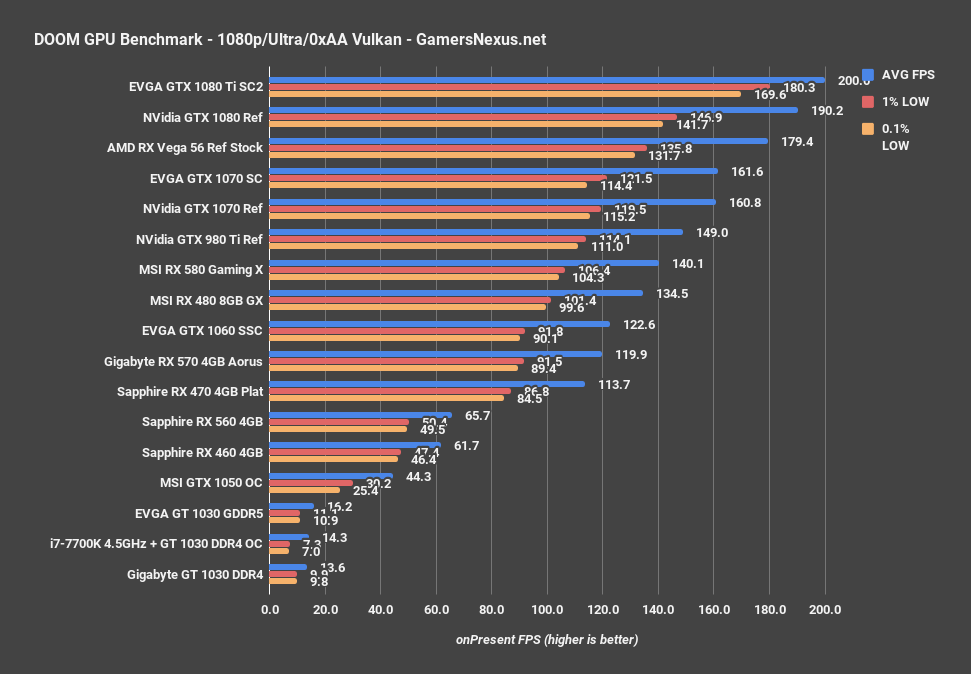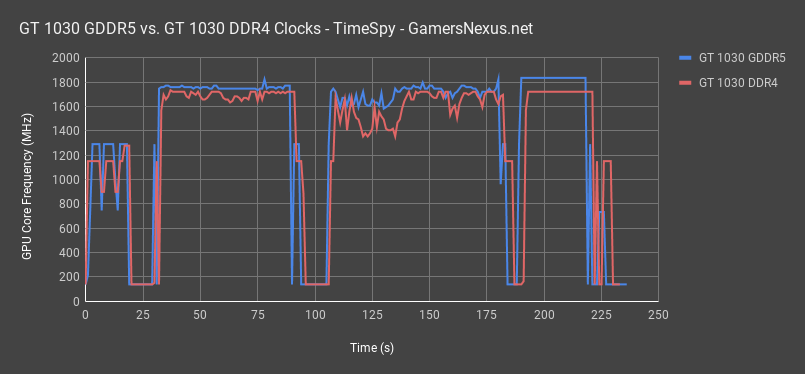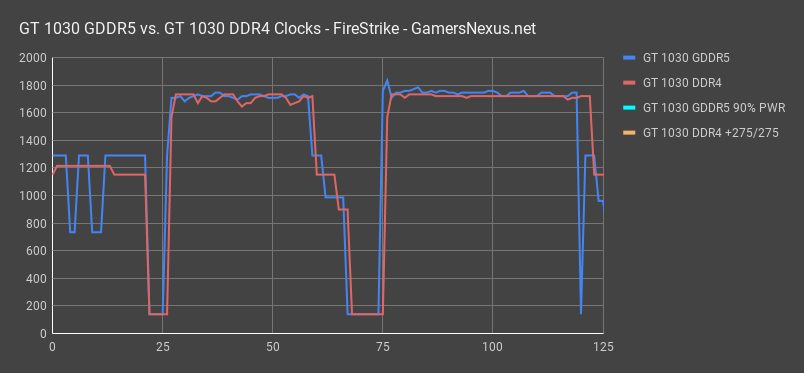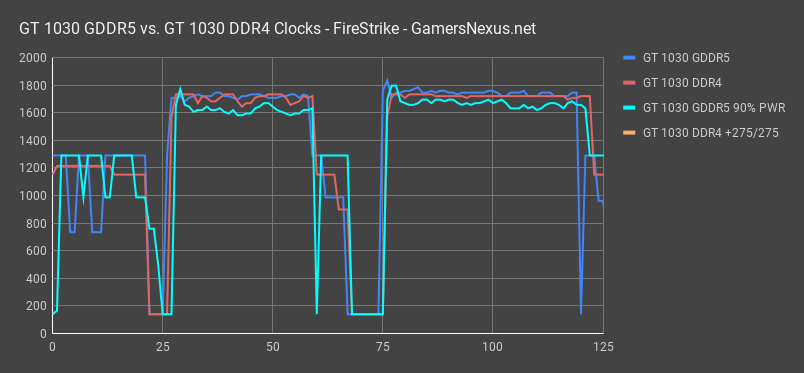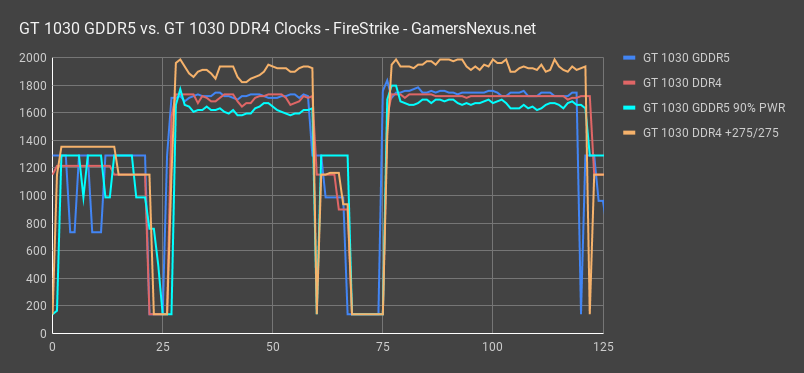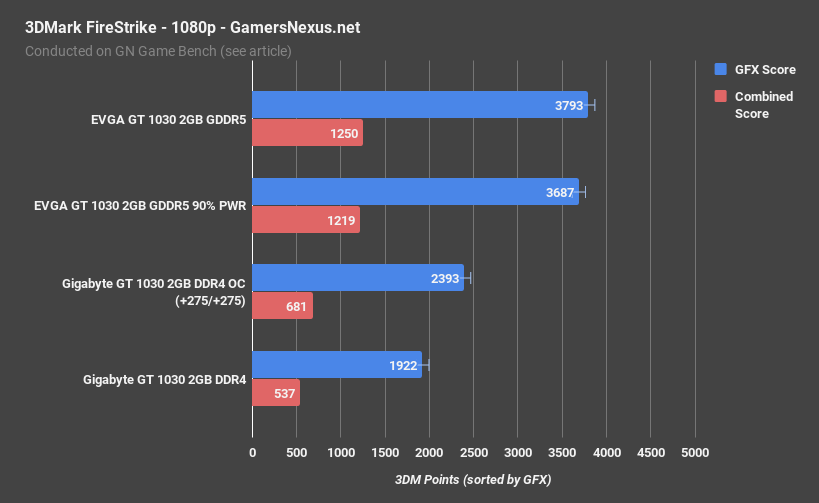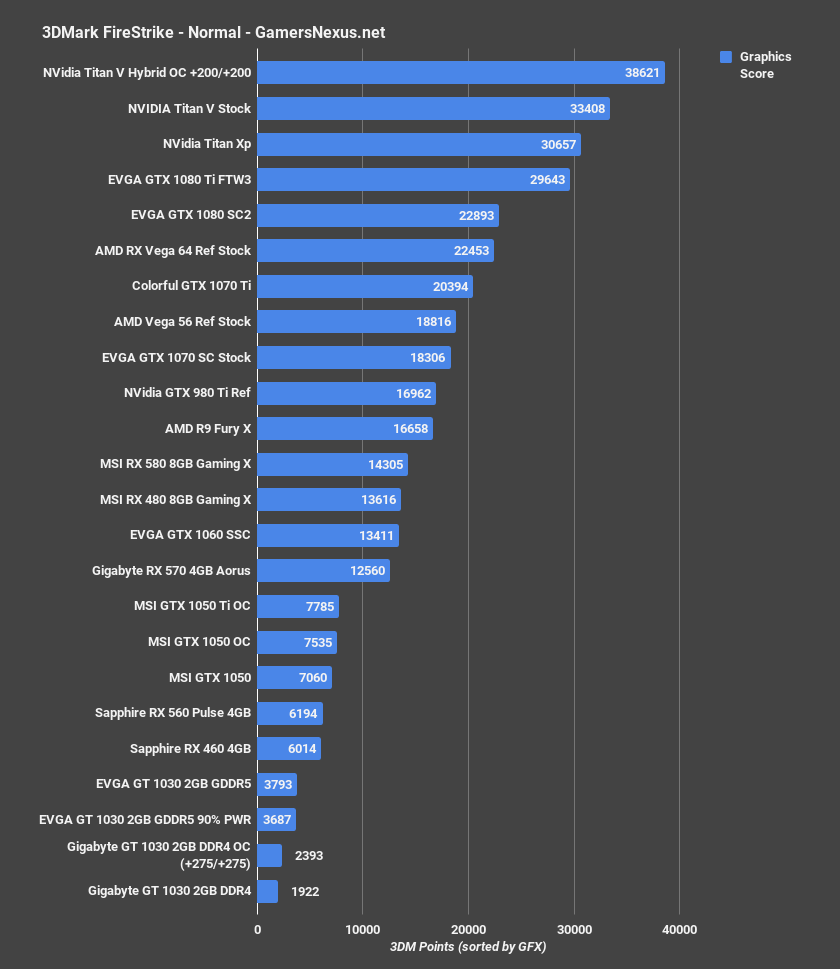This is something we haven’t seen before. NVidia has taken a relatively successful card, the GT 1030, and has implanted DDR4 in place of GDDR5. It’s actually getting system memory on it, which is a tremendous downgrade. The memory bandwidth reduction is several-fold, dropping from 48GB/s to about 16GB/s with DDR4, but the part that’s truly wrong is that they used the same product name.
The GT 1030 has always been an interesting product, and that’s only true because of the mining boom and GPU scarcity issues of earlier this year. Typically, the GT 1030 – or similarly ultra-low-end cards – would not get our recommendation, as a GTX 1050 or RX 550 would make more sense and be close in price. Earlier this year, even GTX 1050s and RX 550s had evaporated, leaving only overpriced GT 1030 GDDR5 cards (that we were somewhat OK with recommending). Fortunately, performance was decent. Was. Before the DDR4 surgery.
It’s time to benchmark the GT 1030 versus the GT 1030 Bad Edition, which ships with DDR4 instead of GDDR5, but has the same name as the original product. In a previous rant, we railed against these choices because it misleads consumers – whether intentionally or unintentionally – into purchasing a product that doesn’t reflect the benchmarks. If someone looks up GT 1030 benchmarks, they’ll find our GDDR5 version tests, and those results are wildly different from the similarly priced GT 1030 DDR4 card’s performance. On average, particularly on Newegg, there is about a $10 difference between the two cards.
The GT 1030 with DDR4 is one of the most egregious missteps we’ve seen when it comes to product marketing. NVidia has made a lot of great products in the past year – and we’ve even recommended the GT 1030 GDDR5 card in some instances, which is rare for us – but the DDR4 version under the same name was a mistake.
Why DDR4 vs. GDDR5 Matters
Graphics devices are extremely bound by memory bandwidth. We’ve seen this with Vega and with some other high-end graphics devices. What we’ve never seen before, though, is DDR4 stuck to a card that would typically have GDDR5. The original GT 1030 carries about 48GB/s of memory bandwidth, calculated by taking memory bus width, divided by 8 to convert width to bytes, multiplied by memory clock, by 2 for DDR, and by 2 for GDDR5. The result is about 48GB/s, whereas the GT 1030 with DDR4 amounts to approximately 16GB/s memory bandwidth. This difference alone is massive, but nVidia also changed the reference clock speeds on the DDR4 version of the GT 1030 by over 100MHz, in some cases.
As for what strains memory bandwidth, it’s just about everything in computer graphics. Texture sampling is a big one, or anything else that collects samples for processing. Anti-aliasing, temporal effects, scales and transforms where data needs to be retained in memory, and so forth. The differences should be exaggerated in games where shaders are lighter load, as memory bandwidth is likely to be more utilized.
Anything that relies on high memory occupancy will strain the GPU’s memory bandwidth. Most of the time, that’d be higher quality textures, anti-aliasing effects, and some fixed function processing. The CPU and geometry pipelines become more bound by draw calls and geometric complexity, whereas the GPU memory becomes more bound by large files getting called for application to objects and meshes, or files that might remain resident in memory for further transforms.
Test Methodology
For this testing, we are using a mix of our low-end GPU test bench games (primarily for APUs) and high-end bench games. The higher-end testing – using DOOM and Sniper – will act as synthetic stand-ins as representations for Dx12 and Vulkan, both with asynchronous compute slants. The lower-end games will more realistically depict the differences between the two GPUs. Remember, our goal is to benchmark the GT 1030 GDDR5 vs. GT 1030 DDR4, not to determine value of APUs, the GTX 1050, RX 550, or other components; however, we have provided data for some of these other components for easy comparison – they’re just not the key comparison today.
Some tests explicitly look at texture filtration imposition on the cards, as texture filtering will impact memory bandwidth to a greater degree than some other types of graphics. Generally speaking, anything that takes samples and stores them will be transactionally intensive on memory, but textures are also bandwidth-intensive.
Low-end games include:
- Rocket League
- DOTA2
- CSGO
We are using the following settings (see screenshots):
High-end tests include:
- 3DMark Firestrike
- 3DMark TimeSpy
- Sniper Elite 4 (settings as in chart)
- DOOM (settings as in chart)
Bench components include the following for the GT 1030 bench (APU benches were defined previously):
GPU Test Bench (Sponsored by Corsair)
| GN Test Bench 2017 | Name | Courtesy Of |
| Video Card | This is what we're testing | - |
| CPU | Intel i7-7700K 4.5GHz locked | GamersNexus |
| Memory | GSkill Trident Z 3200MHz C14 Corsair Vengeance LPX 3200MHz CL16 | Gskill Corsair |
| Motherboard | Gigabyte Aorus Gaming 7 Z270X | Gigabyte |
| Power Supply | NZXT 1200W HALE90 V2 Corsair AX1600iorsair AX1600i | NZXT Corsair |
| SSD | Plextor M7V Crucial 1TB | GamersNexus |
| Case | Top Deck Tech Station | GamersNexus |
| CPU Cooler | Corsair H115i Pro | Corsair |
BIOS settings include C-states completely disabled with the CPU locked to 4.5GHz at 1.32 vCore. Memory is at XMP1. Driver version 388.09 is used for the 1070 Ti.
Rocket League | GT 1030 DDR4 vs. GT 1030 GDDR5 Benchmark
Rocket League is a fairly playable game. Previously, we found Rocket League to operate between 50 and 60FPS AVG on the AMD R3 and R5 APUs, and we found the GT 1030 and G4560 to operate at around 62FPS AVG. Removing the CPU bottleneck for safety, we found the GT 1030 GDDR5 GPU and 7700K at 63FPS AVG, representing a GPU bottleneck, with 1% lows and 0.1% lows in the 40s. The DDR4 version of the GT 1030, stock, ran nowhere close to that framerate. It slumped at 28FPS AVG, a 55% decline in performance from the GDDR5 version of the GPU.
With an overclock offsetting core and memory by 250MHz each, we managed to push to 35FPS AVG, but frametimes suffered as a result. The GT 1030 DDR4 card can’t even achieve half of the performance of the original GT 1030, and they share a name. That’s not right. It can’t even operate anywhere close to the level of an R3 2200G stock APU. This thing is getting obliterated by its memory bandwidth limitations.
This chart shows the frametime performance between the GDDR5 and DDR4 cards. 16ms would represent a 60FPS throughput, and we’d ideally see a flat line, as that’d represent the smoothest frame delivery. In this instance, the DDR4 card struggles to maintain a constant throughput, and chokes regularly on frame-to-frame intervals, resulting in an overall stuttery, unplayable mess when compared to its GDDR5 alternative that costs $10 more.
DOTA2 | GT 1030 DDR4 vs. GT 1030 GDDR5 Benchmark
DOTA2 is next. At 1080p, the R3 and R5 numbers from launch benchmarks put the APUs in the 40s to 50s for framerate, with the GT 1030 and G4560 getting stuck at around 63FPS AVG. Unrestrained by the CPU, we measured GT 1030 GDDR5 performance at 67FPS AVG, with lows at 60FPS and 43FPS.
The DDR4 version managed, shockingly, to carry almost 50% of the original performance. Our GT 1030 DDR4 ran an average framerate of 32, compared to 67 on the model that costs a few bucks more and carries the same name.
This is just embarrassing, so far.
CSGO | GT 1030 DDR4 vs. GT 1030 GDDR5 Benchmark
CSGO is up next, another Valve title. For this one, the AMD APUs at launch stuck around the 80s to 90s for AVG FPS, pre-overclock. The GT 1030 and G4560 did well, operating at 120FPS AVG and receiving our recommendation for an ultra-budget CSGO machine. At least, at the time.
Unrestrained, the GT 1030 with GDDR5 managed 122.7FPS AVG, with lows relatively disparate at 85 and 54FPS. The GT 1030 with DDR4, embarrassingly, managed 55FPS AVG, with 0.1% lows at 25FPS. The translation of these low values is, again, a stuttery mess of frame throughput. We’ll clarify with frametime plots momentarily. 55FPS versus 123FPS is a 55% reduction in performance from the original card. Overclocking the DDR4 card helps, but not in any way that can begin to defray the degradation. Once overclocked, we’re at nearly 2000MHz core versus the 1800MHz core max of the GT 1030 with GDDR5, and yet the performance is still 47% lower.
Here’s a frametime plot. Although neither card is the pinnacle of fluidity, the DDR4 variant can’t keep its frames consistent enough to provide an enjoyable experience without graphics quality or resolution reductions.
AOTS | GT 1030 DDR4 vs. GT 1030 GDDR5 Benchmark
Moving on to Ashes of the Singular—oh, never mind.
This error popped-up when we tried to benchmark with the Ashes DX12 benchmark. The card isn’t even officially supported as a result of its lack of GDDR5. Ashes thinks this card is from the GDDR4 era.
Sniper Elite 4 | GT 1030 DDR4 vs. GT 1030 GDDR5 Dx12, Async
Sniper Elite 4 at 1080p, High, and with Dx12 and async compute acts like a synthetic test, here. Realistically, you’d probably drop to medium settings for playability, but we could still use some stand-in synthetics.
For this one, the GT 1030 with DDR4 again operated at exactly half the speed as the GDDR5 GT 1030, further shaming the poor card’s existence.
DOOM | GT 1030 DDR4 vs. GT 1030 GDDR5 Vulkan Benchmark
We’re treating DOOM the same way – basically synthetically. The reason for this is because we already have data racked-up for other low-end devices with these settings; although the settings are way too abusive for the 1030, we can easily compare it to other devices. The trouble with DOOM is that its 200FPS physics cap means that we have to impose higher settings to restrict the high-end devices, because they’ll hit the 200FPS cap otherwise and appear artificially worse.
Anyway, look at it synthetically: The GT 1030 with GDDR5 manages 16FPS AVG, which is 20% faster than the GT 1030 with DDR4. The gap closes a bit with an overclock. Comparatively, this is miles behind the RX 560 and GTX 1050, which operate at 65.7FPS and 44FPS, respectively.
3DMark Benchmarks & Experiments
It’s probably about time that we start analyzing the clock differences. In most of our previous benchmarks, you saw tests with results for an overclocked GT 1030 DDR4, which included 250MHz offsets for the core and memory clocks. This put the card ahead of the GT 1030 GDDR5 for core clock, but still severely crippled in memory bandwidth.
3DMark TimeSpy Results – GT 1030 DDR4 vs. GT 1030 GDDR5
Here’s a chart showing stock GT 1030 performance in 3DMark TimeSpy. The blue line represents the EVGA GT 1030 with GDDR5. Clearly, this card is operating at higher frequencies in most passes. The difference ranges from marginal, like 1721MHz vs. 1771MHz, or 50MHz different, to more significant, like the end of the test’s 1721MHz vs. 1835MHz gap.
Keep in mind that TimeSpy is extremely memory intensive, and thrashes memory bandwidth in a big way. This further validates our hypothesis that performance dwindles from the inadvisable switch to DDR4.
Here’s an over-time chart for Firestrike. We’ll add more lines as we go. The first two lines are the GDDR5 and DDR4 GT 1030s without modifications. You’ll notice that they’re fairly close overall, indicating that Firestrike would be a good clock-for-clock test without needing manual modification. Our differences never exceed 30MHz, which is reasonable; it’s obvious that a 30MHz difference will never amount to a 50% change in performance, so we can live with this.
We did another test pass with the EVGA GT 1030 GDDR5 card’s core throttled with a 90% power limit. We’ll add that line next. This one regularly dips below the DDR4 card’s core clock, but as you’ll see in a moment, it still outperforms the score of the DDR4 card’s higher core clock.
Finally, this next line shows the overclocked GT 1030 DDR4’s core clock, which was offset by 275MHz for this test. It’s peaking at 2000MHz, which is an impressive gain of nearly 300MHz, in some instances. Even still, performance is behind the GDDR5 card – the core can’t make up for the choke created by memory bandwidth, particularly on texture filtering.
Let’s look at the Firestrike scores associated with these numbers.
3DMark Firestrike Scores
The GT 1030 2GB DDR4 card is an embarrassment, and operates with a graphics score of 1922 and combined score of 537. The GT 1030 with GDDR5, also stock, managed a 3793 graphics score – a 97% performance improvement. This is nearly a 2x change. We know that Firestrike is intensive on GPU memory, and this fully solidifies the DDR4 card’s weakness, had there been doubt.
Just to be sure, we reduced the GT 1030 GDDR5 card’s power allowance to 90%, resulting in a 3687 graphics score. That’s still nearly 2x higher than the DDR4 card. Overclocking the DDR4 card by 275MHz offset results in a 25% increase over the stock DDR4 card, but that’s not enough to claw back the tremendous loss versus the GDDR5 device.
Just in case you were wondering, here’s a Firestrike chart with some other devices on it. We’ll highlight all the 1030 devices. This is tested on the same bench, and provides an easy comparison versus other devices.
Conclusion: GT 1030 DDR4 vs. GT 1030 GDDR5
The GT 1030 GDDR5 received our recommendation on a few occasions, almost all of which were derived from limited supply of the GTX 1050 or RX 550. Even in spite of this forced recommendation, the card did perform objectively well when compared to its predecessor garbage-tier cards. We almost never recommend sub-$100 cards (this one had an MSRP of $70), but the GT 1030 was good enough to warrant in pairing with a G4560, G5600, or R3 CPU.
Unfortunately, because the new GT 1030 obfuscates that choice and conveniently blends its significant DDR4 reduction into product IDs, we must rescind that recommendation. The average consumer cannot reasonably be expected to look at “GT 1030 2GB OC LPD4” and understand that is 55% slower than “GT 1030 2GB OC LPG5.” That is completely ludicrous, and nVidia, for a company so righteous on making “choices clearer for gamers,” sure seems to be obscuring this one. The company only wants some cards to be a clear choice. Not all cards, apparently. This does not benefit gamers.
The sad thing is that, although we wouldn’t like the card, we wouldn’t be offended by its existence had it been named “GT 1020,” or almost literally anything other than an existing product name whose predecessor has 2x the performance.
The GT 1030 DDR4 chokes on all memory bandwidth-intensive tasks. If you are asking what game graphics are bandwidth-intensive, the answer is “all of them.” The GT 1030 DDR4 is a disgrace of a product, and that is only true because of its name. We can no longer recommend the GT 1030 in any capacity, at this time, out of concern that a consumer might purchase the wrong one. The GDDR5 card is fine, but at a $10 reduction, you lose half the performance with the DDR4 card, and that’s an easy mistake to make.
Editorial, Testing: Steve Burke
Video: Keegan Gallick
